The swivel is an incredibly important piece of equipment as it prevents the leash from tangling. Without a swivel the leash would quickly become a tangled mess for any bird that moved around much. A bird needs a swivel that is strong enough for the bating and wear a bird will inflict on the swivel, the cold and hot, the wet and dirt. A bird also needs the appropriate sized swivel - what works for a big Red-Tailed Hawk is likely too big and heavy for a Cooper's Hawk, let alone something smaller.
Some falconers add an additional swivel into the setup in case something happens with the main swivel. A swivel can be added to the tethering point for the leash to attach to, or the leash length can be done with two shorter leashes with a swivel between them. For a bird that bates strange and tends to hang up its equipment, this can be a change that makes everything more safe.
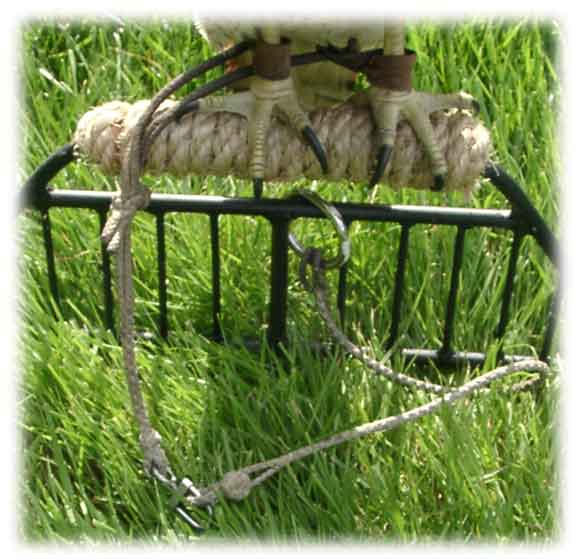 |
A leash that is too long for the perch will end up with the swivel laying on the ground reducing its ability to swivel and keep the equipment from tangling. |
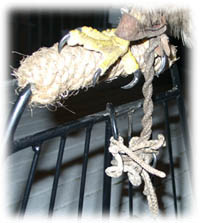 |
An example of what happens when a swivel
becomes trapped and cannot continue to function properly |
Ball Bearing Swivel
The first type of swivel is a simple deep-sea fishing swivel and designed to withstand salt water, temperature changes, and tension. These are easy to come by and can be ordered in bulk from fishing supply catalogs relatively inexpensively. The drawback to this design is that the entire mechanism is hidden so you cannot observe the condition. Many falconers have used this swivel one too many times, had a bird bate and the swivel snap losing a bird. Even a 150# test Sampo can fail on a hawk. If carefully monitored and swapped out regularly, these are excellent swivels. Some falconers put a drop of mineral oil into the mechanism to prevent water from rusting it, or will spray a little metal lubrication such as Knocker Loose or WD-40. Others believe that this only attracts dirt particles which wear down the mechanism. If the bird is in a secondary enclosure, such as a fully enclosed weathering yard, there is less of a concern of the bird escaping should a piece of the equipment break, however there may be a great chance that she will catch the broken equipment on something thereby hanging herself or otherwise injuring herself.
If using the Sampo (ball-bearing) swivels, notice how the two ends are different sizes. The leash should attach to the small end and the jesses should attach to the larger end. The small end is the ball bearing end or swivel end. If the jesses are attached here, they will be more likely to get hung up by trapping the swivel and stopping it from functioning. This style of swivel is best used with a leash that has a button.
Some falconers who use this style swear that the Sampo brand is the only brand they will trust. A Sampo #8 is used for many Red-Tail Hawks. Momoi also makes ball bearing swivels - their #10 would fit a Goshawk. Doug Pineo shared some observations about the Sampo swivel and construction. "The Sampo barrel swivel is a ball bearing swivel, made of nickel plated bronze, with stainless steel bearing balls and stainless steel brazed rings. In the 500 pound test size commonly used in falconry, it weighs approximately 8 times as much as our titanium figure 8 swivel. The swiveling mechanism is invisibly enclosed in the large bronze barrel, which is a swedged, two-piece element. The swiveling pin to which one ring is attached has a head like a box common nail. This head forms one race of the bearing. There are three tiny stainless steel balls. The other race is one half of the swedged barrel. The brazed stainless steel rings on either end of the barrel are much harder than the bronze, so that in a short time in use, each chamfered hole through which the rings run, become four cutting edges as they wear. These cutting edges cause the diagonal nicks in leather jesses, familiar to anyone who has used leather jesses or swivel extenders, with a Sampo swivel."
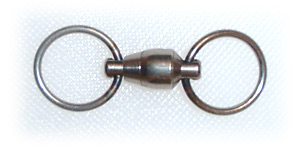 |
A Sampo swivel. |
British Falconer's Swivel
The British Falconer's Swivel or English Swivel is another style. Originally designed by Hardy it features a much simpler design with all the moving parts exposed - to the elements as well as for observation. Typically the jesses attach to the circle portion with the leash attached to the U portion. If a jess extender is used it can attach to the U portion and the bar across the U prevents the jesses from sliding into the swivel mechanism and the leash attaches to the circle portion. Many like the Titanium crafted swivel, however I have found it is so light weight that some birds will jump and the way they move allows the swivel to get flung between the jesses, and when the bird turns the swivel is trapped allowing the bird to become entangled. I prefer the stainless steel and have used them for years without any major incident, no wear visible on the swivel.
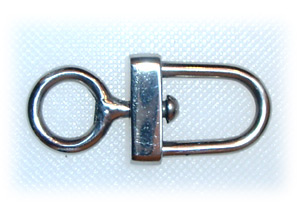 |
A British swivel. |
Figure-8 Swivel
This swivel comes in several different forms, but is basically two closed rings attached to rotate together. The design problem with a figure-8 swivel is that a jess or leash can fall between the rings (where the red arrow is) and get trapped and therefore tangle the bird, although a jess extender almost eliminates this risk, however a jess extender doesn't line up as well so the swivel itself actually swivels better without the jess extender. The well-made swivel below has an additional consideration in that each of the rings in tapered and there is a spacer between the rings. This helps keep the site of attachment (where the leash attaches to the swivel and where the jess attaches to the swivel) at the narrow end of the taper. The swivel is turned in the second picture to show off this feature.
The Figure-8 Swivel made by Doug Pineo is titanium. The lighter swivel may develop less inertia, so is less likely to dive through the jesses to tangle after a falcon or hawk regains her perch or block after bating. However with the British design I have found the opposite to be true for titanium.
Unlike the Sampo swivel, this is an exposed mechanism where the swivel occurs. Doug shared some details about his particular swivel design and production. "Our Titanium Figure 8 swivel has a very simple, and totally visible swiveling mechanism. The free-swiveling ring is attached with a stout connecting pin, with a substantial hemispherical head. The other end is threaded through, and welded to the opposite ring. In these characteristics, our swivel is the same as Mike Melville’s original stainless steel welded swivels from the late 1960’s, and those made later by Steve Little (taught by Mike Melville), who later sold the business to Bill Snell. We make ours in A64V titanium and our spacer is a bushing, not a washer shape. All of the critical components and moving parts are in plain view and can be readily inspected, cleaned and monitored."
 |
A Figure-8 swivel. |
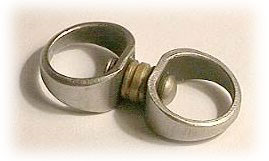 |
A Figure-8 swivel.
Photograph courtesy of Derry Argue; swivel crafted by Derry Argue. |
French Clip and Swivel
This swivel is primarily a clip that also swivels. It has many falconers who love it, and many who hate it. The advantage is that with one quick squeeze, you can release a bird. Because of this it is very handy as a glove clip to release a bird off the fist. It is not to be trusted to leave a bird weathering or as the only clip attached to a leash. One moment of pressure and the bird is loose. Also, many falconers have found that their natural tendency is to grab at a leash setup when they want to hold their bird tightly. This clip responds by releasing the bird and not holding tighter. The weakest point of this structure is the pin in the middle of the scissor action, and it is not meant to be a daily stressed safe snap.
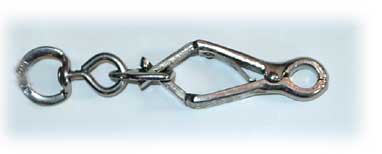 |
A French Clip and swivel. |
Spro Heavy Duty Swivel
This swivel is a salt-water variety and is used here integrated with a leash and jess extender. The advantage is a very light weight setup that is not prone to tangling or twisting. The disadvantage is that you cannot see how the swivel is worn and a swivel failure may happen suddenly and without warning.
A Spro heavy duty #7 or #8 will fit for many medium to large birds.
 |
A Barrel swivel.
Integrated leash and jess extender crafted by Richard Jones. |
Barrel Swivel or Standard Fishing Swivel
This is a very tiny Barrel Swivel and Safety Snap and only appropriate for small birds such as a Kestrel or Merlin. This usually consists of a single swivel and snap attached to the leash branching to two swivels, each snapped to one jess. This is therefore sometimes called a Y-swivel. The Safety Snap is one design for this rig. Another design is the Coastlock Snap, however these tend to fail at slightly higher rates than the Safety Snap. In the past NAFA has disallowed Coastlock Snap swivels from being used in their weathering yard. One problem with some of these arrangements is that there's a thin piece of metal passing through a leather jess, which can stretch the hole or break when the bird bates.
When set up in a Y-swivel arrangement, be careful that the metal rings and edges are not rubbing against the tail as it can cause damage and even broken feathers.
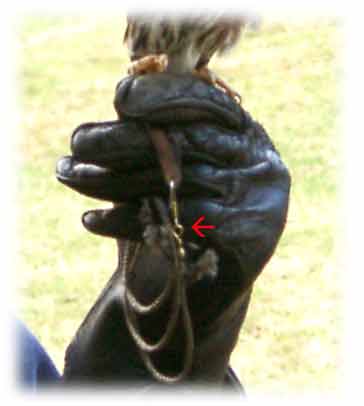 |
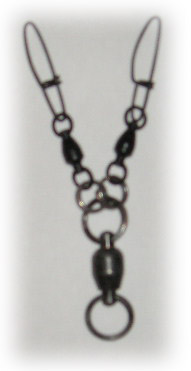 |
| A swivel and snap shown on a Northern Pygmy Owl. | Y-swivel setup. The swivels are Berkley size 6, 275 pd test each. The rings are Hyper Wire size 10, 220 pd test each.
Image courtesy of Gary Hampton. |
Dog Leash Swivel
This is probably the most common sort of swivel and snap that people see, and what they think of before they become falconers. However, this is not a swivel or snap that should be trusted for situations other than a simple glove leash. The physical rigors that a falconry swivel undergoes are far more than what a dog swivel is designed to undergo. The snap also has a faulty design for falconry purposes as it can easily be twisted and release.
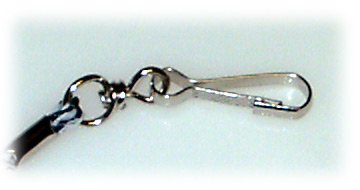 |
A dog swivel and snap. |